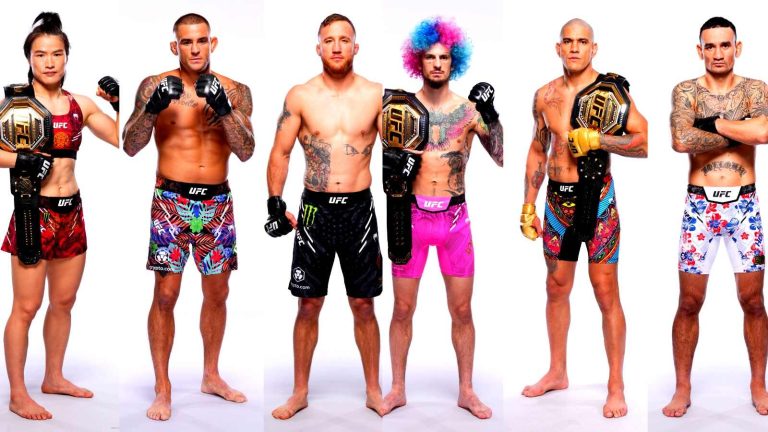If you’ve watched old UFC events from the early 2000s, you may remember fighters walking to the Octagon wearing all sorts of branded gear — from energy drink patches to tattoo shop logos. But today, every UFC fighter walks out in the same uniform, without any visible personal sponsorships.
So what changed?
The answer lies in the UFC’s shift toward a centralized sponsorship model starting in 2015 — a move that completely transformed fighter branding, walkout gear, and how sponsorship money flows in the sport.

A Quick History: When Fighters Could Wear What They Wanted
Before 2015, UFC fighters were free to sign personal sponsorship deals and display logos on:
-
Walkout T-shirts
-
Fight shorts
-
Banners hung inside their corner
-
Even shaved into their heads or tattooed (yes, that happened)
Sponsors ranged from supplement companies to local gyms and gambling sites. For many fighters, sponsorships were a major source of income, especially those lower on the fight card.
But the look of UFC events was also… chaotic. Fighters often looked like “walking billboards,” and there was little control over brand image from the UFC’s perspective.
The Reebok Deal: When Everything Changed
In 2015, the UFC signed a multi-year, exclusive apparel deal with Reebok, marking the beginning of the UFC’s official uniform policy.
Under the agreement:
-
Fighters could no longer wear personal sponsor logos during fight week or on broadcast.
-
Everyone wore standardized gear made by Reebok.
-
The UFC introduced a tiered “fight week outfitting pay” system based on fighter tenure.
This deal was meant to professionalize the UFC brand, make the athletes look more like NFL or NBA players, and attract blue-chip advertisers.
But for fighters? It meant a major loss of personal sponsorship income.
Why Fighters Can’t Wear Sponsors Today
Since the Reebok deal, and now under Venum (since 2021), fighters are still not allowed to wear any personal sponsor logos during:
-
Walkouts
-
Weigh-ins
-
Press conferences
-
Fight week media events
-
The actual fight itself
Instead, the UFC controls all branding and apparel visibility. Fighters receive a flat fee from the UFC’s outfitting partner, based on how many fights they’ve had in the organization — not based on their personal marketability.
️ Example: A fighter with 1–3 UFC bouts might earn $4,000 in outfitting pay, while veterans with 21+ fights get $21,000.
Who Benefits From This Model?
The UFC itself — and its corporate partners — benefit the most:
-
Clean, uniform look for all fighters
-
Easier to attract big sponsors (crypto, beer, betting, apparel)
-
UFC retains control over ad revenue streams
-
Less chance of “problematic” or controversial sponsor logos appearing on broadcast
From a business perspective, this model streamlines branding and helps the UFC negotiate multi-million dollar sponsorship deals that benefit the company more than individual athletes.

Source: www.reddit.com
♂️ How Do Fighters Feel About the Sponsorship Ban?
Many fighters — especially mid-tier and lower-tier ones — have openly criticized the UFC’s exclusive sponsorship model. Here’s why:
❌ Huge Loss in Personal Income
Before the Reebok deal, some fighters were making $20,000 to $100,000 per fight just from sponsors. With the uniform policy in place, many now receive just a few thousand dollars, even if they have massive personal followings.
️ “We used to get paid more in sponsorship than from the actual UFC purse.” — multiple fighters have echoed this point, including Brendan Schaub and Aljamain Sterling.
❌ No Freedom to Monetize Their Own Brand
Fighters can’t promote their sponsors on shorts, walkout shirts, or during media events, even if they have deals outside the UFC. This has left many athletes feeling like independent contractors without independence.
How Fighters Still Work With Sponsors (Behind the Scenes)
While the UFC restricts sponsor visibility during events, fighters still find ways to partner with brands outside of fight week — especially through social media.
1. Instagram and Twitter Promotions
Fighters with strong followings often do:
-
Sponsored posts
-
Product shoutouts
-
Affiliate marketing
This allows them to maintain personal deals without violating UFC policy.
️ 2. Podcasts and YouTube Channels
Fighters like Sean Strickland, Michael Bisping, and Sean O’Malley promote sponsors through their own media platforms — places where the UFC can’t control the ad space.
3. Merch and Fan Apparel
Though they can’t wear sponsor logos inside the Octagon, many fighters launch their own apparel lines or partner with brands to sell exclusive merchandise to fans.
Will UFC Ever Allow Personal Sponsorships Again?
It’s unlikely — at least not in the traditional sense. The UFC is committed to maintaining a centralized, league-style presentation, especially with major partners like:
-
Venum (official outfitter)
-
Monster Energy (official sponsor)
-
DraftKings and Stake (official betting partners)
That said, pressure from fighters and fan awareness may eventually open doors for hybrid models, like:
-
Limited custom branding space on walkout gear
-
Opt-in revenue sharing from UFC sponsors
-
More transparency in outfitting pay calculations
Some MMA promotions like Bellator and PFL still allow personal sponsorships, which gives fighters an incentive to negotiate or shop around if they’re free agents.
Final Take: Sponsorship Rules Protect the Brand, Not the Fighters
The UFC’s ban on personal sponsor logos is all about brand control and maximizing company revenue. While it creates a cleaner, more professional presentation, it also limits fighter freedom and financial opportunity — especially for those who rely on every source of income.
So when you wonder why fighters no longer walk out in branded gear, the answer is simple:
Because the UFC owns the spotlight — and they’re selling it to the highest bidder.

Source: www.reddit.com
The Pros and Cons of Sponsorship Restrictions
As with any policy, there are both pros and cons to the UFC’s restrictions on sponsorships. Understanding these can provide insight into the ongoing debate surrounding the issue.
Pros
- Unified Branding: The UFC’s exclusive sponsorship deals create a cohesive brand image, making it easier for fans to identify fighters and the organization as a whole.
- Professionalism: By limiting sponsorship visibility, the UFC aims to maintain a level of professionalism during events, reducing distractions for viewers.
- Simplified Marketing: Exclusive deals simplify the marketing process for the UFC, allowing the organization to focus on its partnerships with major brands.
Cons
- Financial Limitations: Fighters may struggle to make ends meet due to the restrictions on sponsorships, particularly those who are not top earners.
- Branding Opportunities: The limitations hinder fighters’ ability to promote their personal brands and build relationships with sponsors.
- Frustration Among Fighters: Many fighters express frustration over the lack of control they have over their sponsorships, leading to discontent within the community.
Real-Life Examples: Fighters and Sponsorship Challenges
To illustrate the impact of sponsorship restrictions, let’s look at real-life examples of fighters who have navigated these challenges.
Example 1: Conor McGregor
Conor McGregor is one of the most recognizable figures in MMA, and his success has been closely tied to his sponsorship deals. However, even McGregor faced challenges when the UFC implemented exclusive sponsorship agreements. His ability to showcase his personal brand was limited, impacting his overall income.
Example 2: Fighters on the Undercard
Many fighters on the undercard struggle to make a living due to the restrictions on sponsorships. For instance, a fighter who may have had multiple sponsors before the Reebok deal found themselves with limited income opportunities. This situation highlights the financial disparity between top-tier fighters and those lower on the card.
Example 3: The Rise of Alternative Revenue Streams
In response to sponsorship limitations, some fighters have turned to alternative revenue streams, such as social media and merchandise sales. By building a strong online presence, fighters can connect with fans and generate income outside of traditional sponsorships. This shift underscores the adaptability of fighters in the face of challenges.
❓Frequently Asked Questions: UFC Sponsorship Rules
1. Can UFC fighters wear sponsor logos on their shorts or shirts?
No. Since 2015, UFC fighters have not been allowed to wear personal sponsor logos on any fight week gear, including walkout shirts, shorts, or hats. All visible apparel must come from the UFC’s official outfitter — currently Venum.
2. How much do UFC fighters get paid from the Venum deal?
Payouts are based on the number of UFC fights a competitor has had. As of 2024:
-
1–3 fights: $4,000
-
4–5 fights: $4,500
-
21+ fights: $21,000
-
Title challengers: $32,000
-
Champions: $42,000
These amounts are paid per fight, not per sponsor.
3. Can fighters still have sponsors outside of the UFC?
Yes — fighters are allowed to sign sponsorship deals privately. However, they cannot display or mention those sponsors during UFC broadcasts, interviews, weigh-ins, or on any fight week apparel. Most choose to promote their sponsors through social media, YouTube, or personal merch.
4. Why did the UFC ban personal sponsors in the first place?
The UFC shifted to a uniform model starting with its Reebok deal in 2015 to:
-
Create a clean, professional look
-
Maintain control over sponsor visibility
-
Attract major advertisers and league-level deals
This centralized approach is similar to how the NFL or NBA handles branding.
5. Do other MMA promotions allow personal sponsors?
Yes. Promotions like Bellator, ONE Championship, and PFL still allow fighters to wear sponsor logos on their shorts and in the cage. This makes them more attractive to fighters who want freedom to earn outside the cage.


